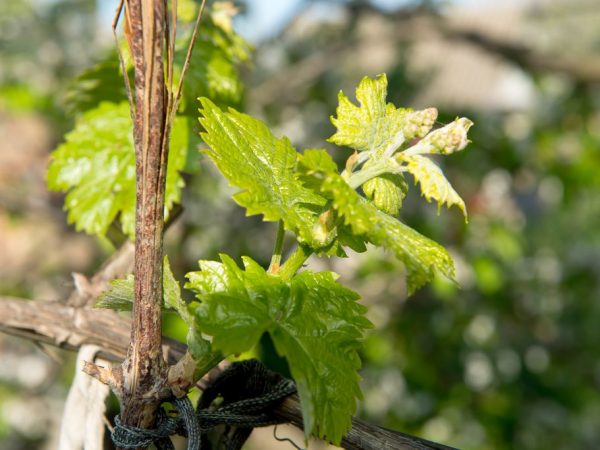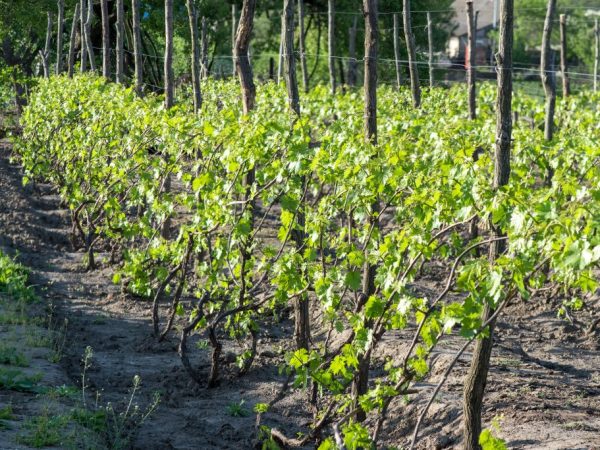Features of garter grapes in spring
In order for the grapes to grow and develop actively, it is important to organize appropriate conditions for them. Tying grapes in spring is a necessary procedure. Tying affects the health and yield of the crop.

Features of garter grapes in spring
Why tie up grapes
The garter is a mandatory agricultural technique in the process of growing grapes. It's all about the active growth that is observed in the culture in the spring. With the beginning of sap flow, the vine stretches. After it is overgrown with shoots and foliage. Unkempt plantings are poorly illuminated by the sun and can suffer from pests and fungal diseases. It also affects the volume of the harvest. Plants correctly spread on a trellis allow the flowering to be well pollinated.
Tying up the grapes in the spring is necessary for the convenience of further cultivation. If this procedure is performed correctly, follow-up care will not be a problem. A tied plant is convenient for watering, pruning, spraying, etc. It is also important that tying is a good way to create a shaded area near the house. This applies to an adult vineyard.
Garter methods
When building an arch or trellis, take into account that the stretched wire between the pillars and supports should be in the form of a lattice. You can also use a special growing net. The vine must lie correctly on the support, which in the future will lead to good growth of the plantings and to a large harvest.
To tie up grapes in spring, it is important to consider the characteristics of both dry and green garters. In the spring, pruning of old damaged vines is carried out. At the end, a dry garter is carried out. They do it like this:
- bend the branches to the lower horizontal wire;
- knots located next to the wire are tied to the net;
- the young shoots formed in the future are also tied to the net.
They turn to the second method later, when the grown shoots grow to 30-35 cm. Without additional support, such bushes will not be reliably protected from gusts of wind, so you will have to tie the branches vertically or at an angle. This method will come in handy for gardeners in the summer, because during this period the bushes need more reliable support.
Gardeners consider the green method inconvenient, especially when growing covering varieties. Vertical attachment of the vine threatens with poor development of its middle part. It can break when laying the bush for the winter. It is also important that with this method of tying the lower buds develop poorly, which brings inconvenience to organizing spring pruning.
Tying technique
The tying technique has many features. So, it is important to make sure that the vine is not pinched by wire or other garter material. It is also important to avoid slipping, therefore it is recommended to bend around the stem of the plant with a figure eight or a loop.
The most effective professional device is the tapiner.Such a device resembles a stapler in many ways, but is intended only for tying up plants. Soft polyethylene is used to fix the vine with tapiner. Such a device is effective for keeping large vineyards. To properly tie up grapes (in spring or summer) in small plantations, it is inappropriate to spend money on buying a tapiner.
Recommendations for beginners

We create all the conditions for good cultivation
It is important to follow some recommendations for organizing the grape garter in spring. All of them are associated with improving the conditions for growing crops.
- It is important for a novice winegrower to use materials for tying that will not harm the plant during its growth.
- Wire is not recommended (except for the main vine). It is more advisable to use a washcloth, thread and cloth tapes.
- Main shoots should be tied horizontally, and annuals and biennials should be tied vertically. It is important to handle young plants with care so as not to accidentally over-tighten the vine, securing it securely.
- Of particular popularity among gardeners are striped women's tights or stockings. Such material is elastic and durable, which is exactly what is needed for the proper tying of plants.
Other recommendations are also important to help the gardener not make mistakes in the early years of growing a crop.
- For reliability and to prevent the plant from hitting the wire, they are tied up with an eight (they describe an eight around the vine and wire with a thread, cord or ribbon).
- Use a garter piping and loop knitting scissors. These tools not only make gardening easier, but also speed up.
- Make sure that the vine does not bend at a large angle. A smooth slight bend is allowed.
- Annual shoots are not recommended to be tied up by internodes that are located at their end.
For young bushes, it is enough to dig in small pegs and tie the plants to them with a cloth or plastic strip. It is more difficult with mature plants. A reliable trellis of wire stretched between metal or wood posts is required. A special mesh may also be required.
Taking into account the recommendations, it will turn out to tie up the grapes in the spring without making mistakes. The main thing is to monitor the growth of the plant and timely attach the grown shoots to the made trellis.
How to make supports or trellises
It is necessary to make a trellis or supports even for a young plant. You can make them yourself using wooden pegs. Already in the first year after planting seedlings, it is necessary:
- prepare 2 beams 1.5-2 m high;
- dig them into the ground on opposite sides of the bushes to a depth of 40-50 cm (the distance between the posts depends on the number of seedlings);
- stretch the wire between the posts at a distance of 40 cm from the ground.
If necessary, the wire is pulled in rows with the same distance from each other.
The larger the bush becomes, the more important it is to make a reliable support for it. Instead of a wooden beam, you can also use metal pipes or channels. The resulting design will be more reliable, but you will have to drill holes for the wire.
Conclusion
Even a novice gardener can make a grape garter correctly. The main thing is to know the technique of the garter, as well as its main features. Distinguish between dry method of operation and green. The grower will have to study both, since they replace each other as the culture grows.


